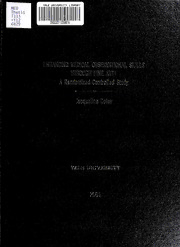
Enhancing medical observational skills through fine art : a randomized controlled study PDF
Preview Enhancing medical observational skills through fine art : a randomized controlled study
YALE UNIVERSITY CUSHING/WHITNEY MEDICAL LIBRARY li Permission to photocopy or microfilm processing of this thesis for the purpose of individual ! scholarly consultation or reference is hereby granted by the author. This permission is not to be interpreted as affecting publication of this work or otherwise placing it in the public domain, and the author reserves all rights of ownership guaranteed ! under common law protection of unpublished manuscripts. Date Digitized by the Internet Archive in 2017 with funding from Arcadia Fund https://archive.org/details/enhancingmedicalOOdole ENHANCING MEDICAL OBSERVATIONAL SKILLS THROUGH FINE ART : A Randomized Controlled Study A Thesis Submitted to the Yale University School of Medicine in Partial Fulfillment of the Requirements for the Degree of Doctor of Medicine by Jacqueline Dolev 2001 VALE MEDICAL LIBRARY AUG 2 4 2in)1 (Vlad Li/o Til 3 ■IYl3 Abstract ENHANCING MEDICAL OBSERVATIONAL SKILLS THROUGH FINE ART A Randomized Controlled Study Jacqueline C. Dolev, and Irwin Braverman. Department of Dermatology, Yale University School of Medicine, New Haven, CT. The purpose of this study is to determine whether first year medical students can learn and enhance the observational skills necessary for medical diagnosis by studying and discussing paintings. The study was conducted at the Yale University School of Medicine and the Yale Center for British Art (YCBA) over two academic years. One hundred seventy-six (176) first year medical students participated. In 1998-1999 ninety students were randomly assigned to three groups: the YCBA group, the lecture group and the control group. The YCBA groups studied and discussed paintings with their peers and the museum Curator of Education. The control groups attended their regularly scheduled clinical tutorial session, in which they were taught clinical skills by a physician preceptor. The lecture group attended an anatomy lecture targeted at teaching students how to read x-rays. In 1999-2000, eighty-six students were randomized into the YCBA and control groups only, after the preliminary data revealed that the lecture group’s observational skills were unchanged after attending the didactic lecture (p=0.928). All students were given a performance exam before and after their event. A predetermined key was used to grade blindly students’ ability to describe the visual features necessary for medical diagnosis in a series of color photographs. Students’ medical observational skills were tested along two time points, the pre-test (T,), and post-test (T2). Post-test scores differed between the two groups for both years [two way repeated measures ANOVA, [F (1,144) = 8.9, p=0.003]. YCBA students achieved significantly higher scores and improved more often than the control. Students also completed a word list search task after their events in 1999-2000. The YCBA group’s mean scanning rate was found to be significantly faster than the control group (p=0.035). Groups YCBA (n = 81) Control (n = 65) Lecture (1998 only, n = 30) Pre- Test exam 50% (± 10%) 47%(± 10%) 46%(± 14%) j Post-Test exam 57%(± 09%) 46%(± 11%) 46%(± 12%) First year medical students can and do learn medical visual skills by studying and describing representational paintings.
